Analysis of the Causes of Excessive Noise and Vibrations of Live Steam Pipelines
Abstract
1. Introduction
- -
- Products of fuel combustion, i.e., produced as by-products of the power plant fuel cycle. Such products include the following: fumes containing fly ash (dust), sulfur dioxide, nitrogen oxides, carbon monoxide and dioxide, slag from boilers, and waste and wastewater from fuel desulphurization (dustiness also occurs during the transport, storage, and unloading of fuels).
- -
- The natural environment is significantly affected by industrial wastewater, which is the by-product of water purification for steam cycles and cooling cycles and is also produced by fuel desulphurization systems, as well as systems for heating water in rivers (lakes) if turbines are cooled by means of an open cooling system. Closed cooling systems—based on ventilators and towers—produce noise [1,2,3], which leads to complaints from residents in nearby areas.
- -
- Electrical networks, through the impact of electromagnetic fields, also have a detrimental effect on the natural environment.
- -
- Noise.
- -
- Noise caused by transformers and engines;
- -
- Noise caused by turbines [4];
- -
- Noise caused by the unloading and crushing of coal;
- -
- Noise produced by air and fume extraction fans and compressors;
- -
- Noise caused by steam collectors;
- -
- Noise from other sources.
2. Description and Parameters of the Pipeline
3. Measurement of Vibrations of the Live Steam Pipelines
- -
- Bandwidth range from 0.1 to 250 kHz;
- -
- Maximum scan speed—100 points per second;
- -
- Vibration velocity range—1 μm/s to 10 m/s;
- -
- Displacement range—1 μm to 160 mm;
- -
- Laser type—633 nm (red) He-Ne laser, with power lower than 1 mW;
- -
- Scanning range ±20° about X, Y;
- -
- Angular resolution < 0.002°.
- -
- The velocity and the RMS values of vibrations at individual measurement points;
- -
- Mode shapes at individual levels [8], where measurements were taken;
- -
- Amplitude–frequency spectrums for individual measurement points in order to evaluate if the structure does not operate in the resonant bands.
- -
- The highest recorded RMS vibration velocity (Table 1) in power unit A at the level of 17 m was VRMS,17,A = 10.92 mm/s;
- -
- The lowest vibration level was recorded at the level of 36 m, where the RMS value of vibration was about 50% lower than the vibrations at the level of 17 m;
- -
- The dominating vibration frequency recorded at all levels of the noise-generating power unit A was fA = 957 Hz, which is in close match to the structural modal modes identified in numerical simulations (see Section 6);
- -
- In comparison, the results of measurements taken on power unit B, whose parameters are identical to those of the noise-generating unit A, show that the highest RMS value of vibration velocity (Table 1) was VRMS,12,B = 3.70 mm/s, with a vibration frequency of fB = 7.5 Hz;
- -
- The mode shape of the pipeline in unit A has characteristics of a sinusoidal-wave shape transmitted along its axis. A mode shape of this type was not observed in unit B [8]
4. Vibration Measurements Using a Handheld Dual-Channel Accelerometer
5. Measurement of the Sound Level Using an Acoustic Camera
6. Numerical Analysis of Vibrations of the Live Steam Pipelines
7. Summary and Conclusions
- -
- A change in the geometry of the pipeline elements resulted in a change in the parameters of the broadband noise generated in one of those elements.
- -
- Parameters of acoustic transmission were on the border of effective sound transmission, and as a result of the change, the effective frequency of transmission (957 Hz) overlapped with the range of generated noise. The results include an effective reinforcement of lateral vibrations of the steam column, pipe resonance, and effective transmission of sound into the environment.
- -
- Vibrations are probably generated in the vertical segment near the nozzle and probe. They are propagated effectively for both Y-pipes. Further propagation in steam is very difficult; this frequency is strongly dampened, but vibrations may propagate in the pipe material and above the vertical segment due to the fact that the value of natural frequencies in all these pipes is approximately 957 Hz. As the distance from the 508 mm × 55 mm pipe increases, the vibration waves in the pipe material disperse, and the level of noise decreases [10,13,14,20,21].
- -
- The nozzle located near the level of 17 m and the probe located near the nozzle;
- -
- The Y-pipe at the level of 42 m;
- -
- Steam valves located in pipeline branches above the top Y-pipe;
- -
- The Y-pipe at the level of 9 m.
Author Contributions
Funding
Institutional Review Board Statement
Informed Consent Statement
Data Availability Statement
Conflicts of Interest
References
- Engel, Z.; Engel, J.; Kosała, K. Procesy Wibroakustyczne Źródła, Badania, Analiza; WIMiR AGH: Kraków, Poland, 2009. [Google Scholar]
- Engel, Z. Ochrona Środowiska Przed Drganiami i Hałasem, Wydanie Drugie Poprawione i Uaktualnione; Wydawnictwo Naukowe PWN: Warszawa, Poland, 2001. [Google Scholar]
- Engel, Z.; Piechowicz, J.; Stryczniewicz, L. Podstawy Wibroakustyki Przemysłowej; Uczelniane Wydawnictwa Naukowo-Dydaktyczne AGH: Kraków, Poland, 2003. [Google Scholar]
- Shin, Y.S.; Wambsganss, M.W. Flow-induced vibration in LMFBR steam generators: A state-of-the-art review. Nucl. Eng. Des. 1977, 40, 235–284. [Google Scholar] [CrossRef]
- Bosnjak, S.M.; Zrnic, N.D. Dynamics, failures, redesigning and environmentally friendly technologies in surface mining systems. Arch. Civ. Mech. Eng. 2012, 12, 348–359. [Google Scholar] [CrossRef]
- Weber, F.; Maślanka, M. Frequency and damping adaptation of a TMD with controlled MR damper. Smart Mater. Struct. 2012, 21, 055011. [Google Scholar] [CrossRef]
- Fusaro, G.; Billi, R.; D’orazio, D. Multiphysical design for optimised ventilation and noise attenuation in ducts: An approach using metamaterials. In Proceedings of the INTER-NOISE24, Nantes, France, 25–29 August 2024; pp. 8163–8171. [Google Scholar]
- Wójs, K.; Szulc, P.; Tietze, T.; Sitka, A. Concept of a system for waste heat recovery from flue gases in a coal-fired power plant. J. Energy Sci. 2010, 1, 171–178. [Google Scholar]
- Zienkiewicz, O.C.; Taylor, R.L. The Finite Element Method, 4th ed.; McGRAW-HILL Book Company: New York, NY, USA, 1991; Volumes 1–2. [Google Scholar]
- Rusiński, E.; Czmochowski, J.; Górski, A.; Iluk, A.; Moczko, P.; Paduchowicz, M.; Pietrusiak, D. Pomiary i Analiza Nadmiernego Hałasu Oraz Drgań Rurociągu Pary Świeżej Bloków 7 i 8 w Elektrowni Bełchatów; Raport Nr 33/2013; PWr: Wrocław, Poland, 2013. [Google Scholar]
- Czmochowski, J.; Górski, A.; Paduchowicz, M.; Rusiński, E. Diagnostic method of measuring hanger rods tension forces in the suspension of the power boilers combustion chamber. J. Vibroengineering 2012, 14, 151–156. [Google Scholar]
- Dobrociński, S. Modelowanie Zagadnień Obliczania Naprężeń Cieplnych; WNT: Warszawa, Poland, 2000. [Google Scholar]
- Kostowski, E. Promieniowanie Cieplne; Wyd. Naukowe PWN: Warszawa, Poland, 1993. [Google Scholar]
- Kostowski, E. Przepływ Ciepła; Wydawnictwo Politechniki Śląskiej: Gliwice, Poland, 2000. [Google Scholar]
- Jabłoński, M.; Ozga, A. Distribution of Random Pulses Acting on a Vibrating System as a Function of Its Motion; AGH University of Science and Technology Press: Kraków, Poland, 2013; ISBN 978-83-7464-660-4. [Google Scholar]
- Maślanka, M.; Sapiński, B.; Snamina, J. Experimental study of vibration control of a cable with an attached MR damper. J. Theor. Appl. Mech. 2007, 45, 893–917. [Google Scholar]
- Taller, J. (Ed.) Procesy Cieplne i Przepływowe w Dużych Kotłach Energetycznych. Modelowanie i Monitoring; Wydawnictwo Naukowe PWN: Warszawa, Poland, 2011. [Google Scholar]
- Yoshihiro, O.; Yoshinobu, T. Three-dimesional transient thermall stresses of functionally graded rectangular plate due to partial heating. J. Therm. Stress. 1999, 22, 35–55. [Google Scholar]
- Ocampo Ramirez, A.; Hernández Gómez, L.H.; Núñez Carrera, A.; Armenta Molina, A.; Fernández Valdés, D.; Escalona Cambray, F.; Guzmán Escalona, M.A. Evaluation of the Acoustic Noise Inside the Main Steam Line of a BWR/5 Nuclear Reactor. Appl. Sci. 2025, 15, 3974. [Google Scholar] [CrossRef]
- Jabłoński, M.; Ozga, A. Determining the distribution of values of stochastic impulses acting on a discrete system in relation to their intensity. Acta Phys. Pol. A 2012, 121, A-174–A-178. [Google Scholar] [CrossRef]
- Smolnicki, T.; Stańco, M.; Pietrusiak, D. Distribution of loads in the large size bearing—Problems of identification. Teh. Vjesn.—Tech. Gaz. 2013, 20, 831–836. [Google Scholar]


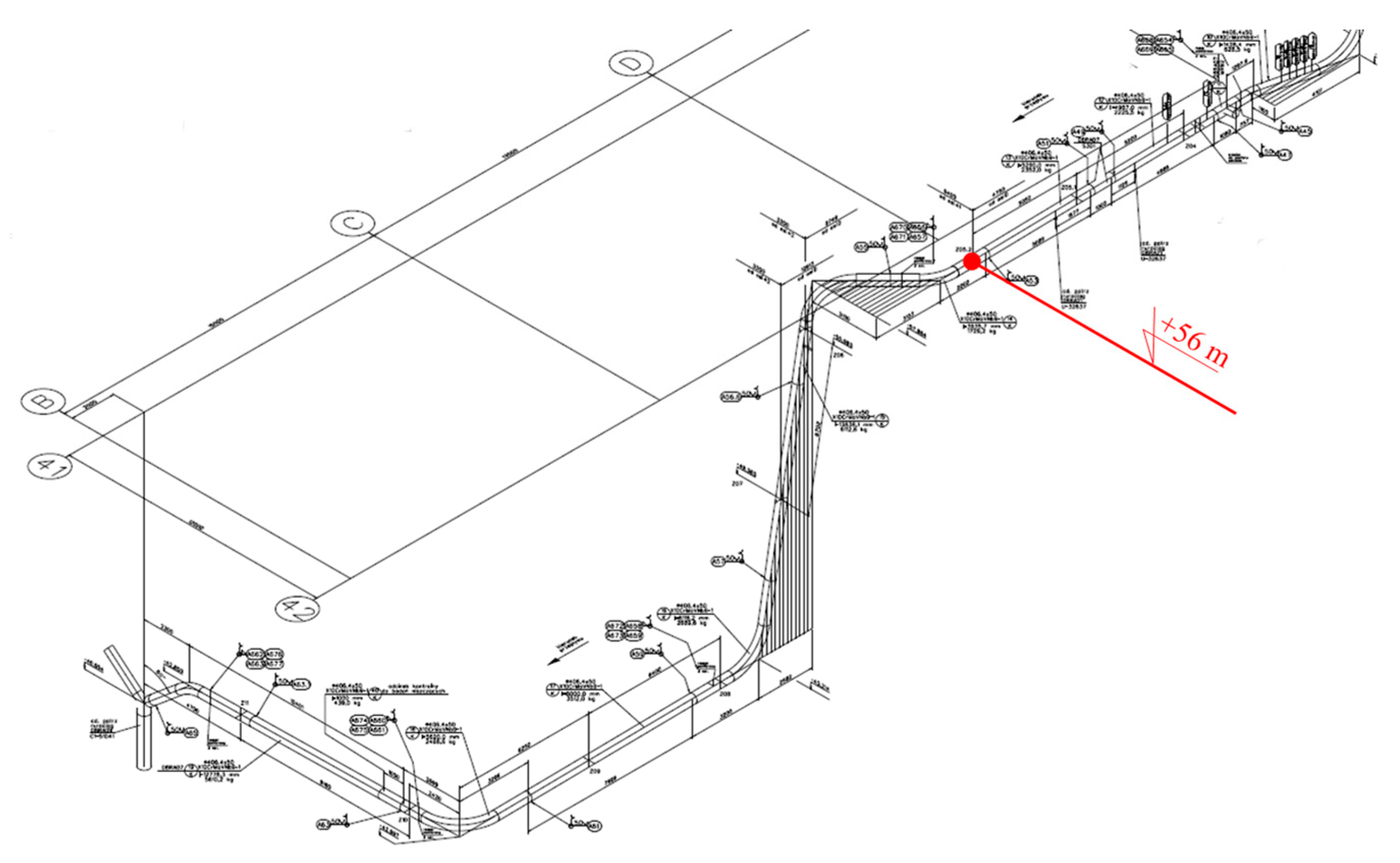

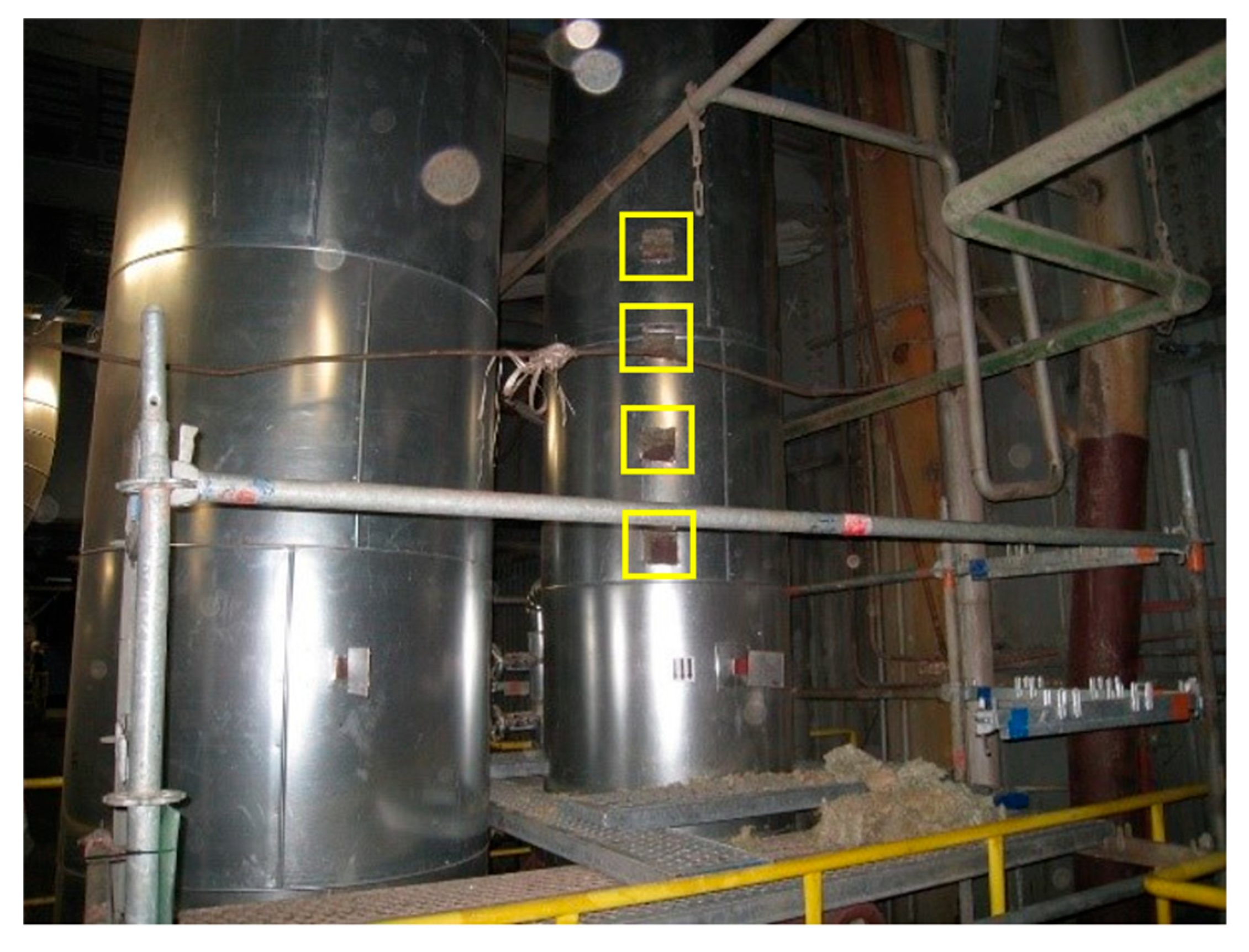

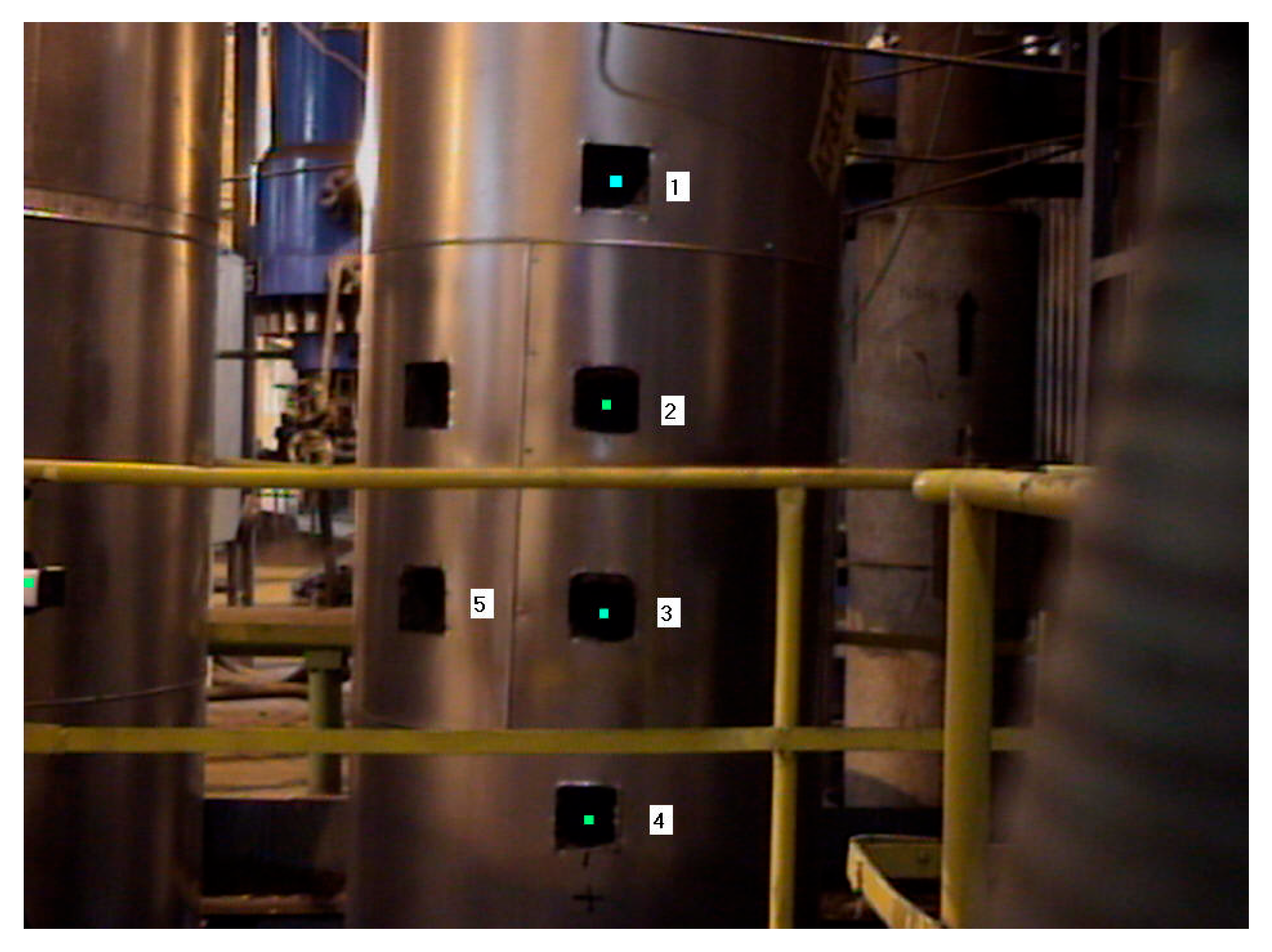
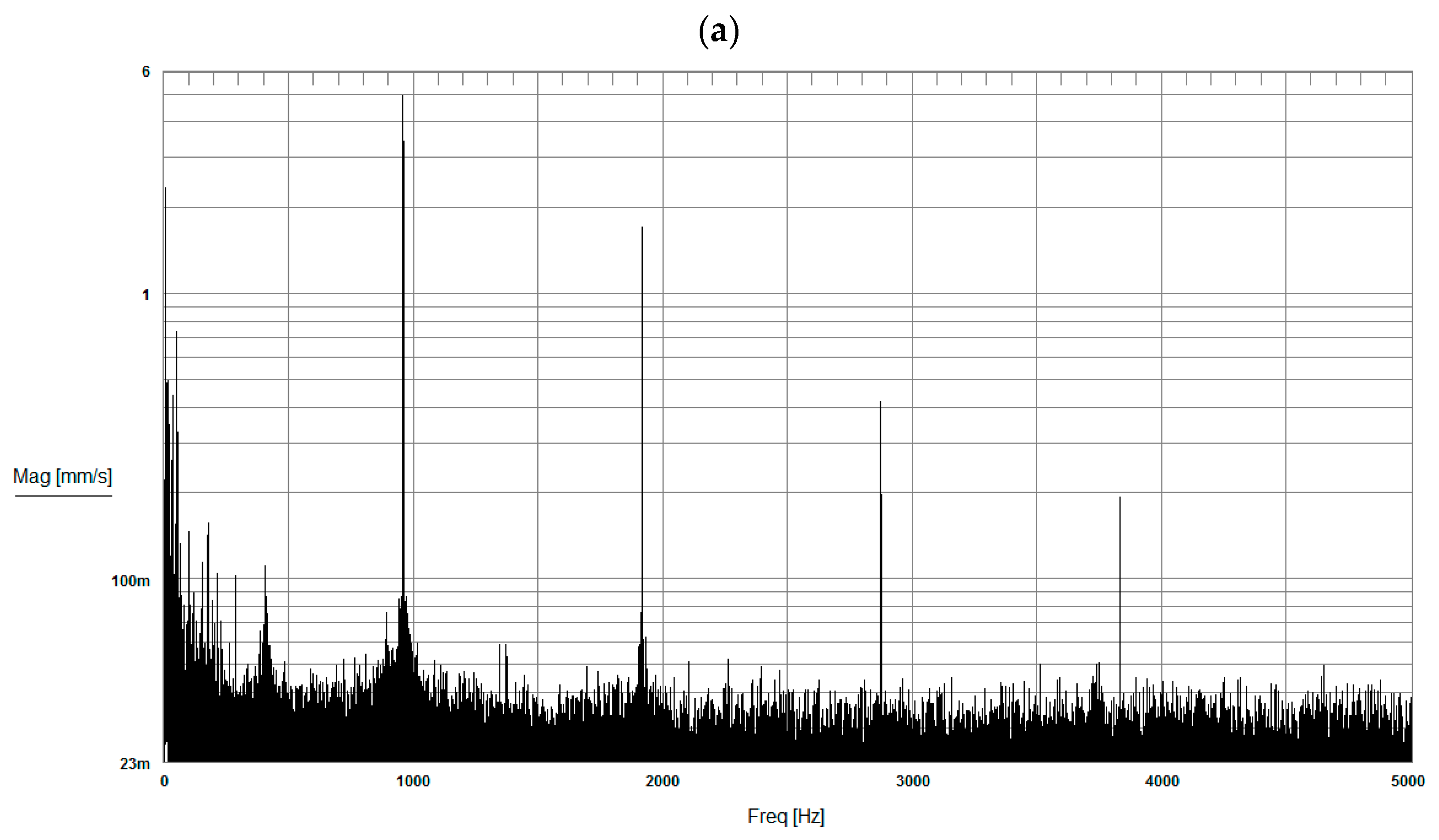

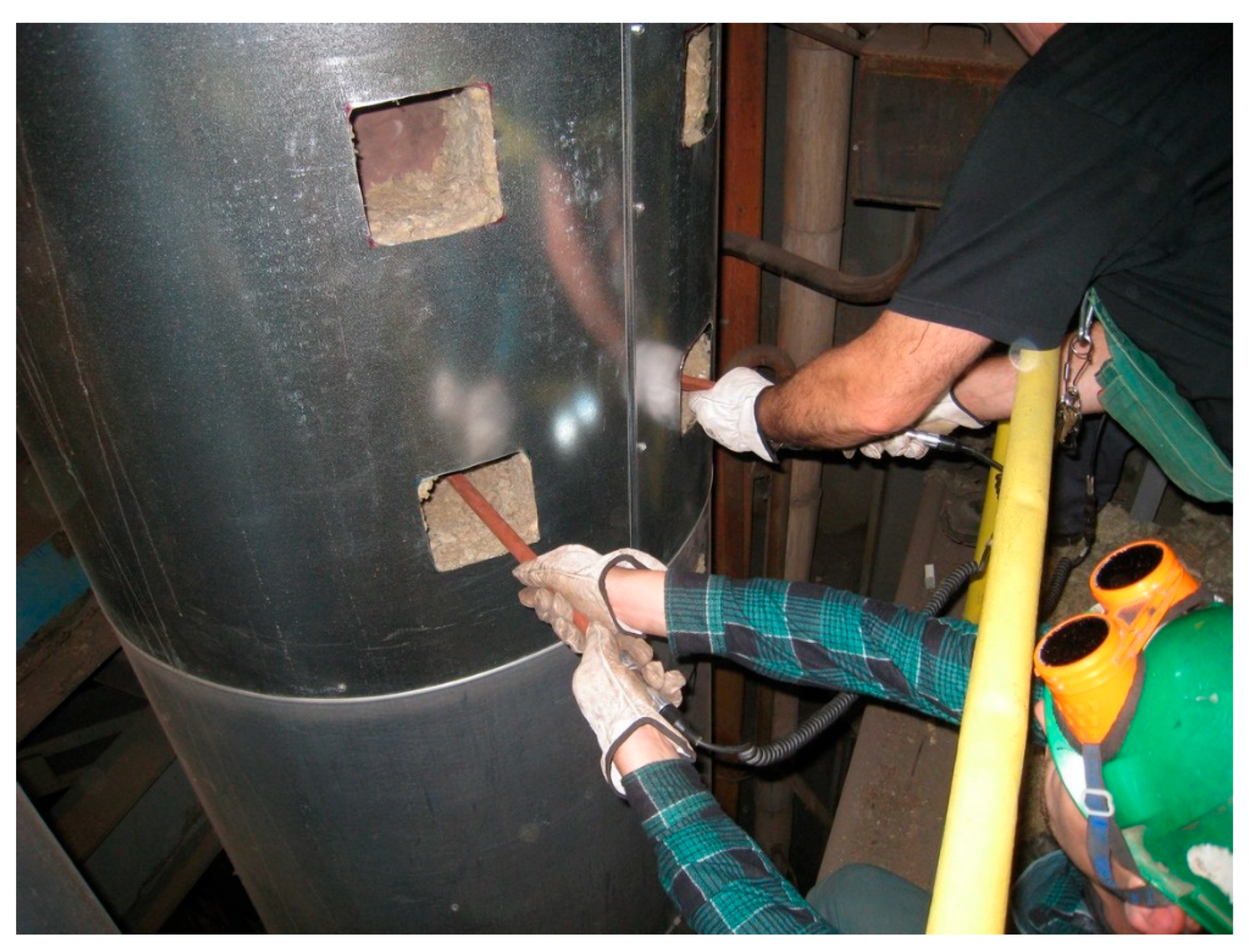
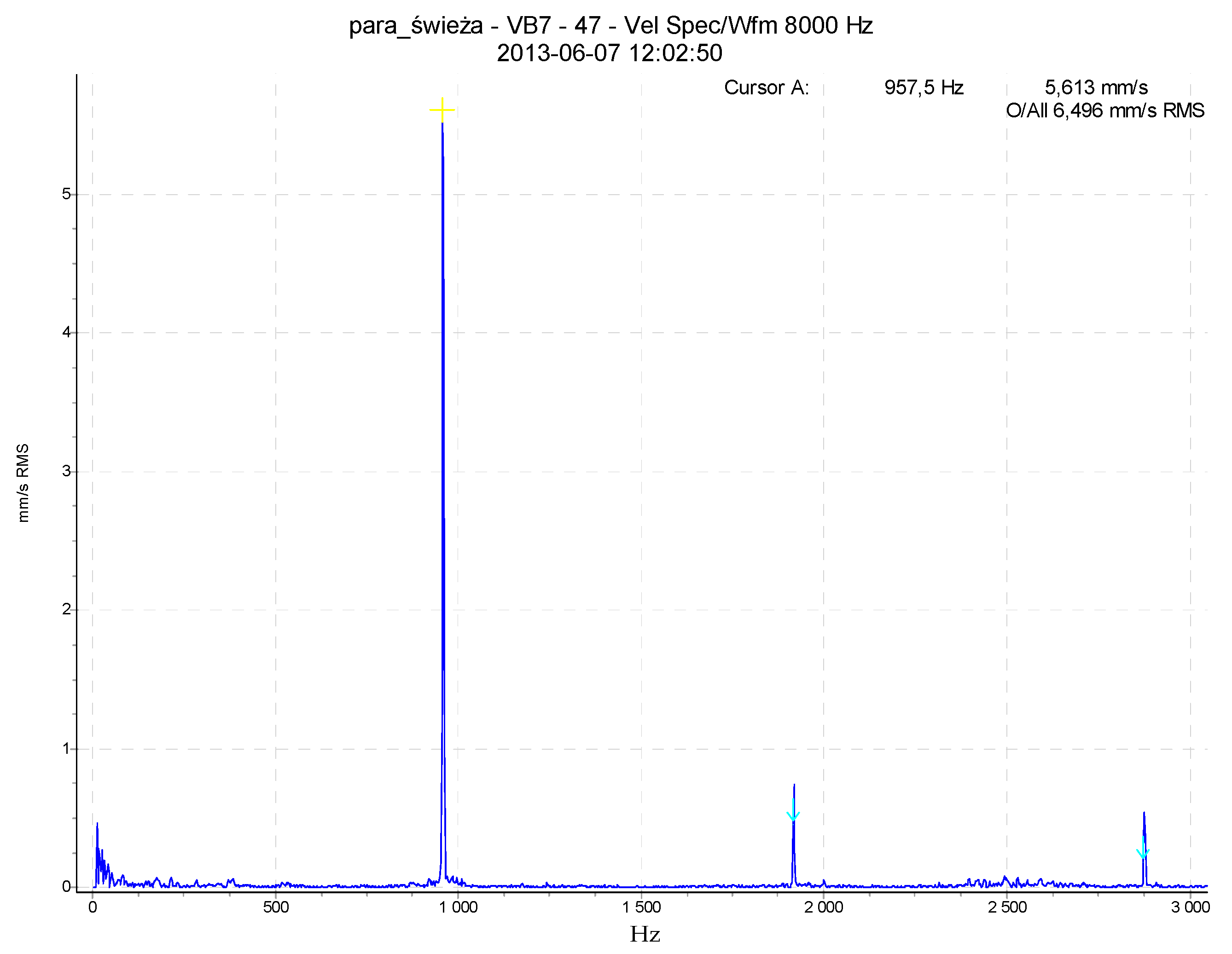
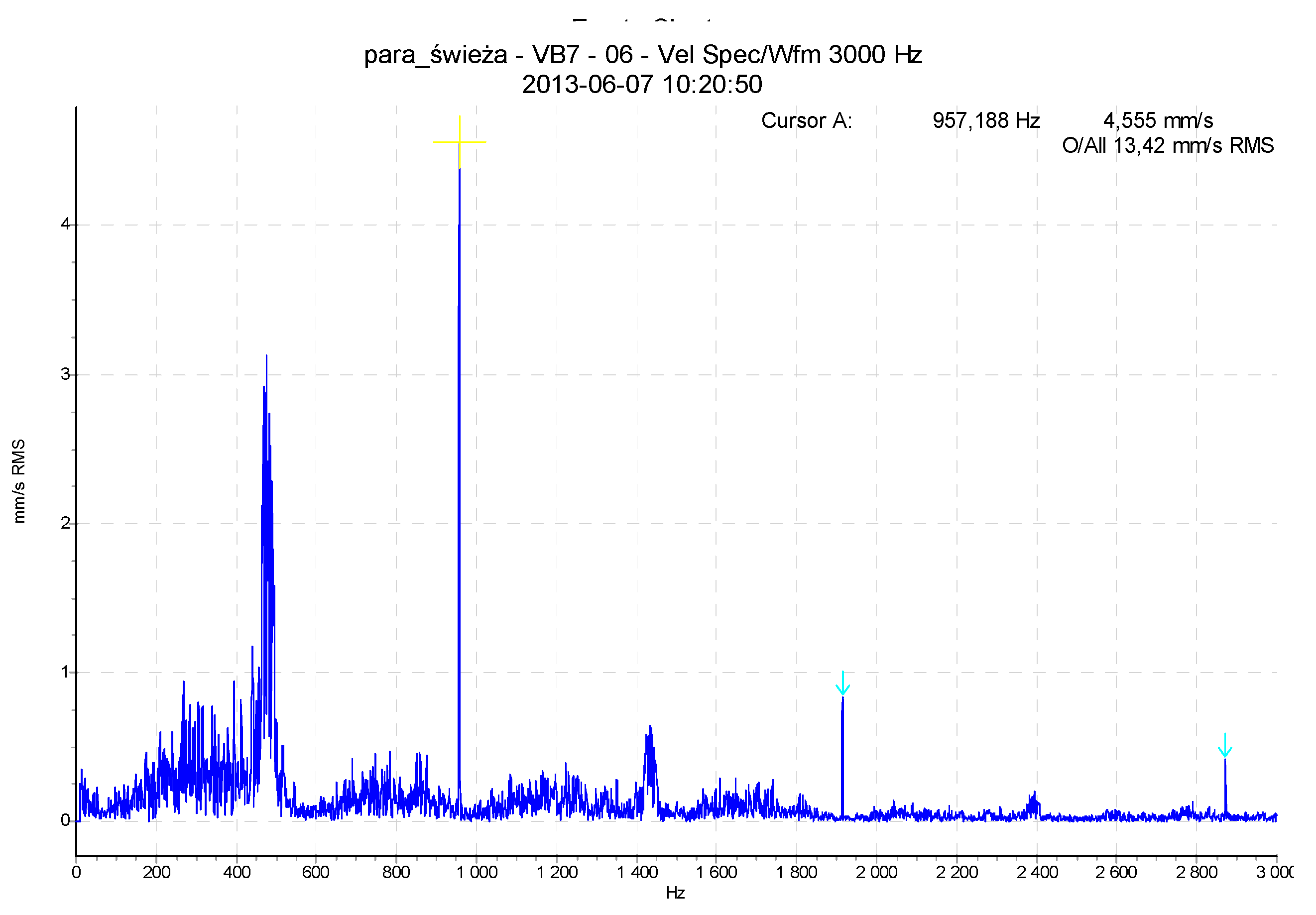

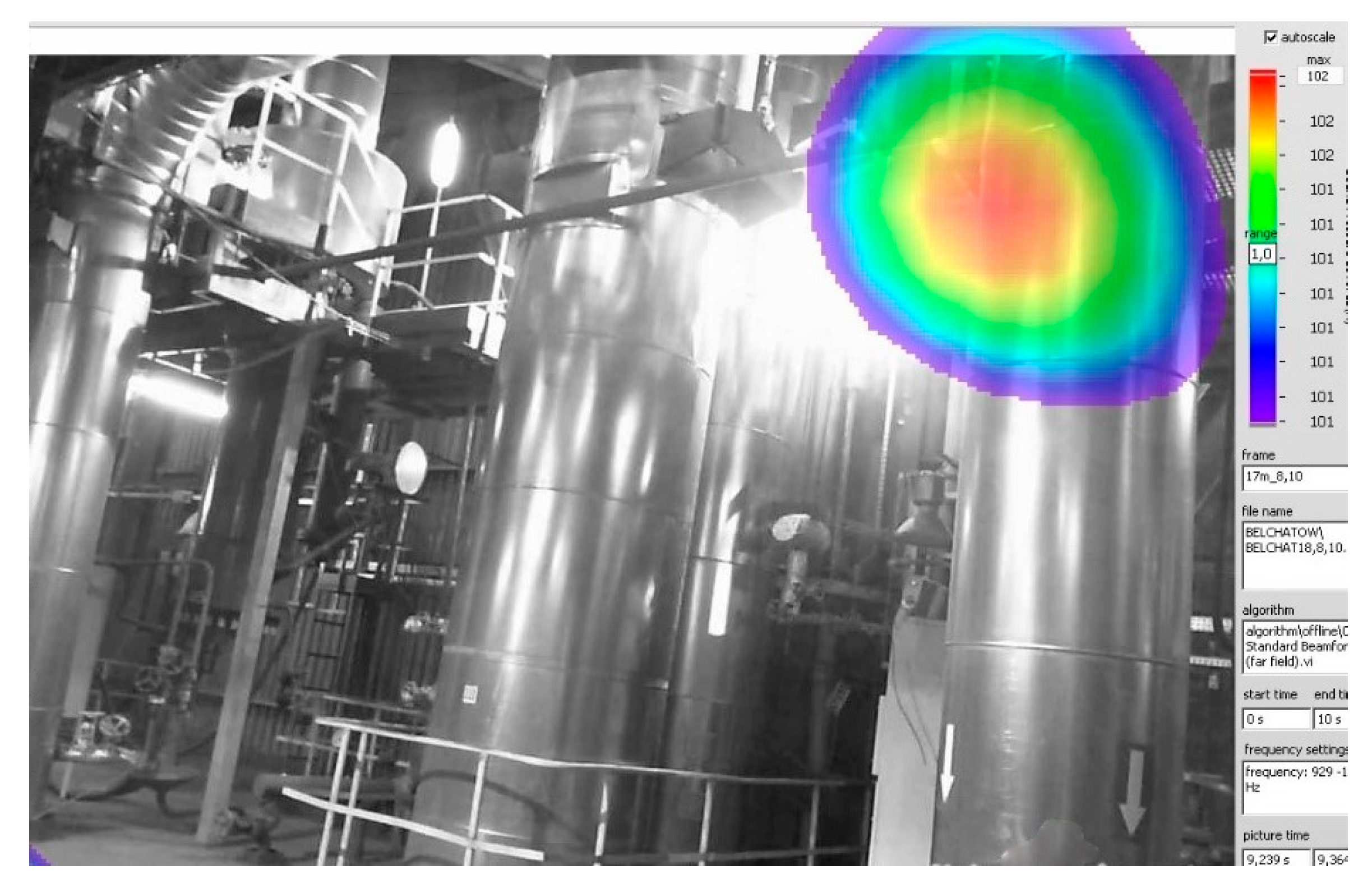

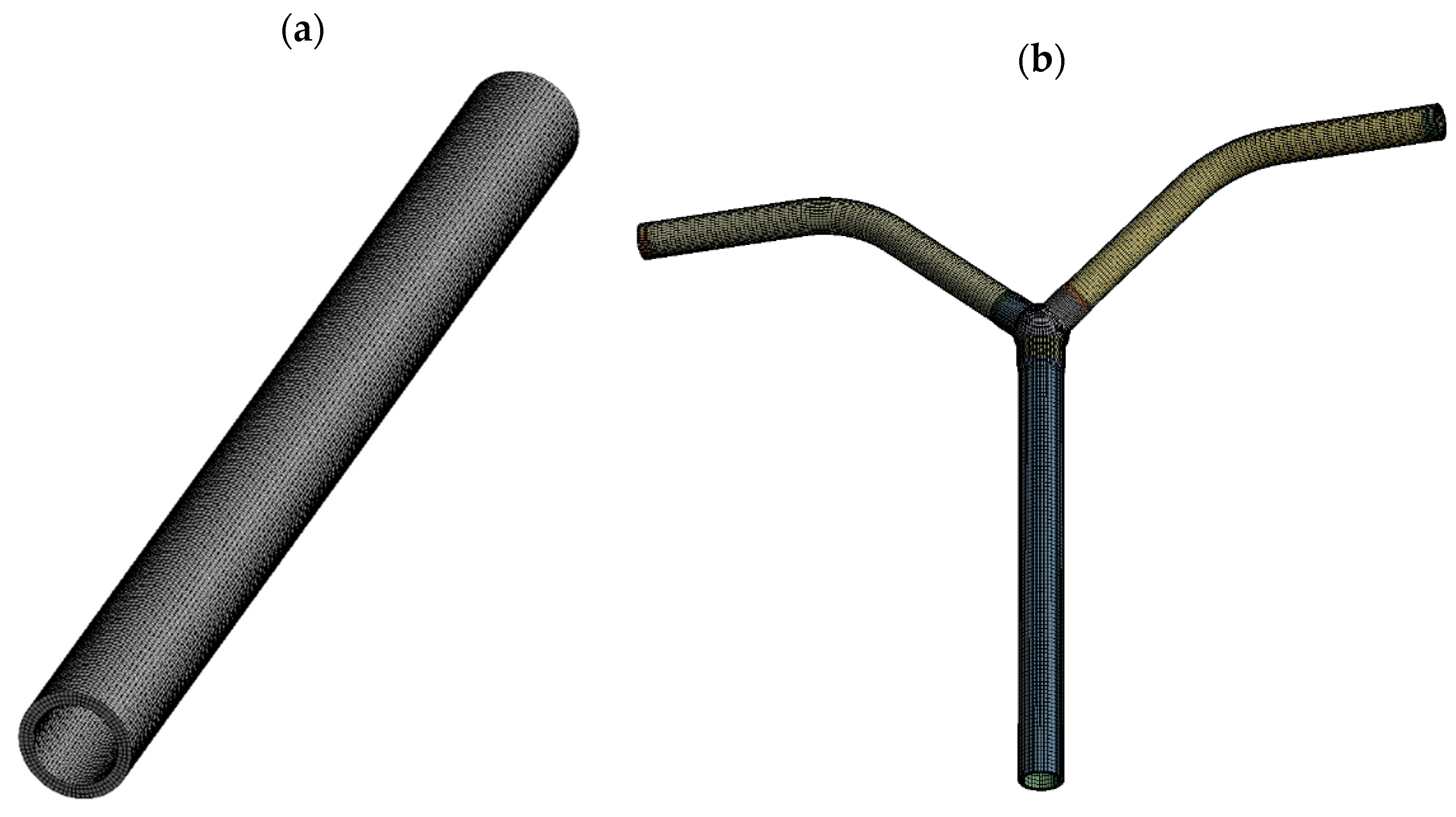
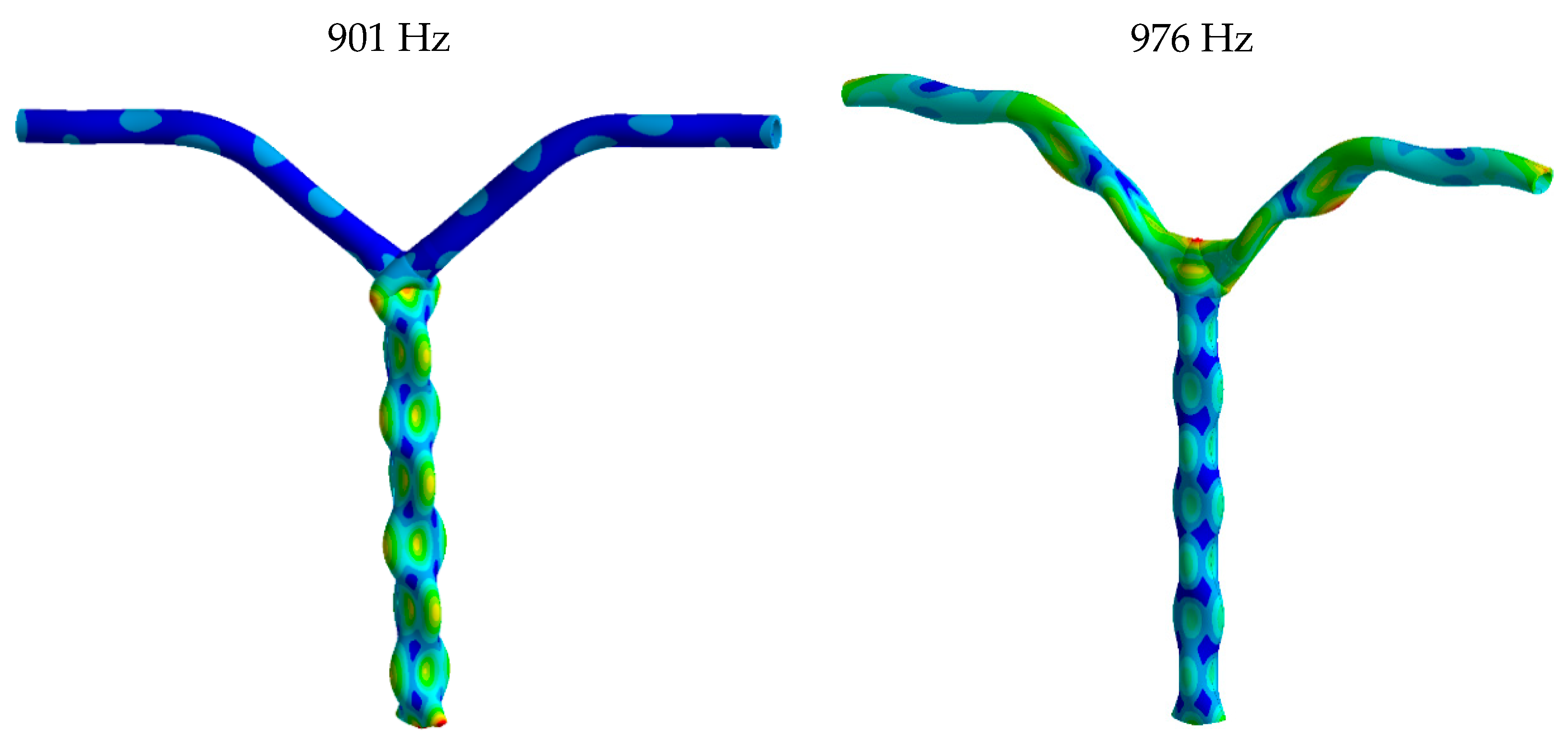
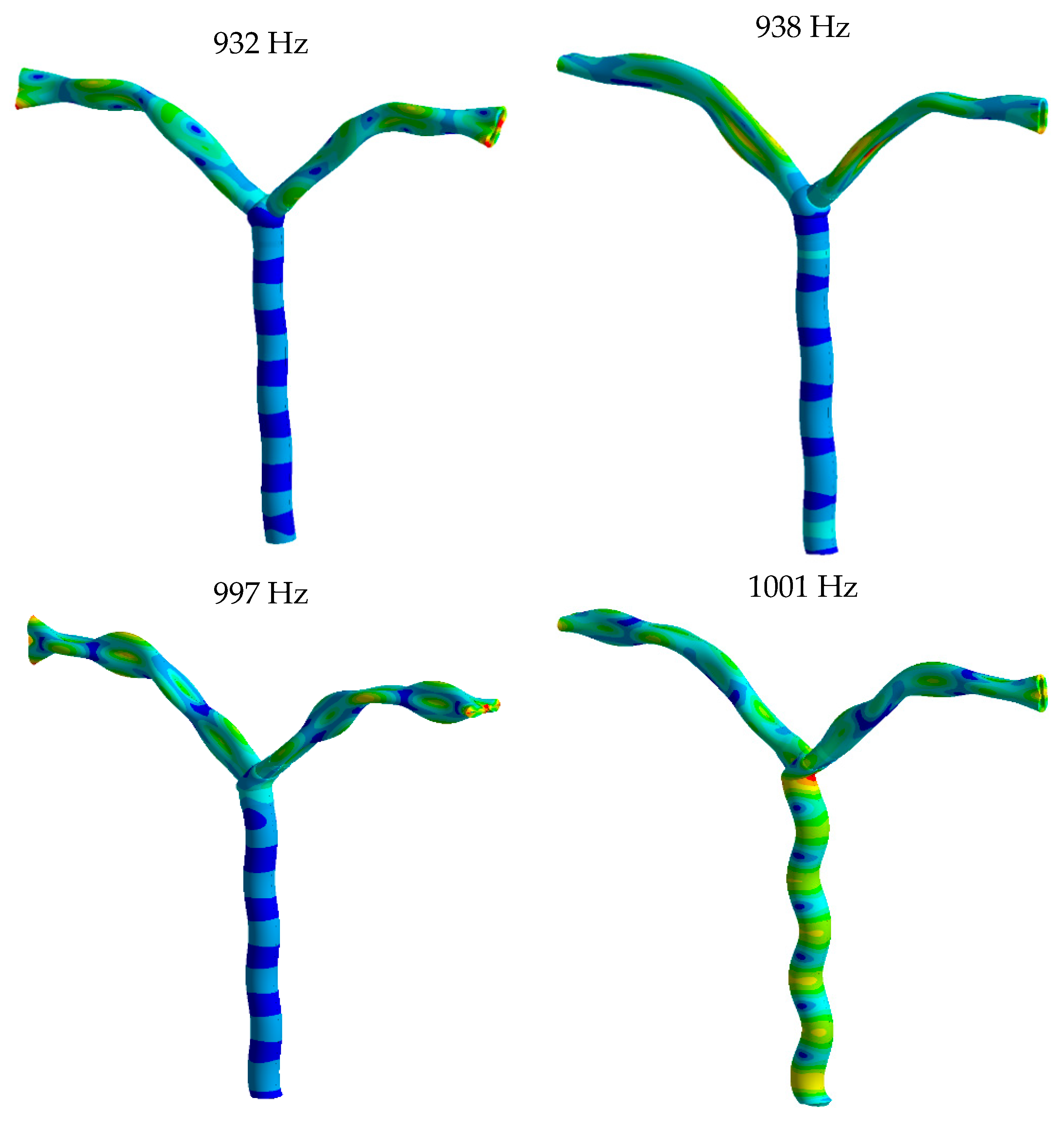
| Measurement Point | VRMS [mm/s] | ||
|---|---|---|---|
| Level of 12 m | unit | A | B |
| 1 | 4.61 | 3.70 | |
| 2 | 6.49 | 2.82 | |
| 3 | 4.25 | 3.17 | |
| 4 | 8.26 | 2.85 | |
| 5 | 4.30 | - | |
| Level of 17 m | unit | A | |
| 1 | 8.18 | ||
| 2 | 9.15 | ||
| 3 | 3.91 | ||
| 4 | 10.92 | ||
| 5 | 7.76 | ||
| Level of 36 m | unit | A | |
| 1 | 4.60 | ||
| 2 | 6.84 | ||
| 3 | 3.99 | ||
| 4 | 5.66 | ||
| 5 | 5.65 | ||
| Values of Live Steam Parameters | Nominal Operating State | Operating State on 2013-06-07 | |
|---|---|---|---|
| A Unit | Temperature [°C] | 575 | 555.6 |
| Pressure [MPa] | 19.6 | 18.7 | |
| B Unit | Temperature [°C] | 575 |  |
| Pressure [MPa] | 19.6 |  |
| No. | Nominal State—Unit A | Measurement—Unit A | Nominal State—Unit B |
|---|---|---|---|
| Hz | Hz | Hz | |
| 1 | 901 | 905 | 927 |
| 2 | 934 | 941 | 962 |
| 3 | 936 | 943 | 995 |
| 4 | 950 | 957 | |
| 5 | 974 | 981 | |
| 6 | 999 | 1002 |
| No. | Description of Mode Shape | Ø355.6 × 40 | Ø406.4 × 50 | Ø508 × 55 |
|---|---|---|---|---|
| Hz | Hz | Hz | ||
| 1 | flexural 5 half waves | 905 | ||
| 2 | circular 1 half wave | 948 | 920 | 636 |
| 3 | circular 2 half waves | 954 | 928 | 645 |
| 4 | circular 3 half waves | 963 | 942 | 663 |
| 5 | circular 4 half waves | 980 | 966 | 697 |
| 6 | circular 5 half waves | 1009 | 1003 | 753 |
| 7 | circular 6 half waves | 833 | ||
| 8 | circular 7 half waves | 935 | ||
| 9 | flexural 6 half waves | 998 |
Disclaimer/Publisher’s Note: The statements, opinions and data contained in all publications are solely those of the individual author(s) and contributor(s) and not of MDPI and/or the editor(s). MDPI and/or the editor(s) disclaim responsibility for any injury to people or property resulting from any ideas, methods, instructions or products referred to in the content. |
© 2025 by the authors. Licensee MDPI, Basel, Switzerland. This article is an open access article distributed under the terms and conditions of the Creative Commons Attribution (CC BY) license (https://creativecommons.org/licenses/by/4.0/).
Share and Cite
Pietrusiak, D.; Czmochowski, J.; Górski, A.; Iluk, A.; Moczko, P.; Paduchowicz, M. Analysis of the Causes of Excessive Noise and Vibrations of Live Steam Pipelines. Appl. Sci. 2025, 15, 6925. https://doi.org/10.3390/app15126925
Pietrusiak D, Czmochowski J, Górski A, Iluk A, Moczko P, Paduchowicz M. Analysis of the Causes of Excessive Noise and Vibrations of Live Steam Pipelines. Applied Sciences. 2025; 15(12):6925. https://doi.org/10.3390/app15126925
Chicago/Turabian StylePietrusiak, Damian, Jerzy Czmochowski, Artur Górski, Artur Iluk, Przemysław Moczko, and Michał Paduchowicz. 2025. "Analysis of the Causes of Excessive Noise and Vibrations of Live Steam Pipelines" Applied Sciences 15, no. 12: 6925. https://doi.org/10.3390/app15126925
APA StylePietrusiak, D., Czmochowski, J., Górski, A., Iluk, A., Moczko, P., & Paduchowicz, M. (2025). Analysis of the Causes of Excessive Noise and Vibrations of Live Steam Pipelines. Applied Sciences, 15(12), 6925. https://doi.org/10.3390/app15126925








